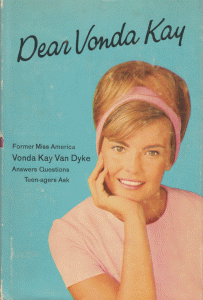 Last weekend I visited a favorite Baltimore spot: The Book Thing, mostly so I could drop off a donation of 5 boxes of books. I came home with only 7 books in return, which isn’t so bad given that all the books there are free and you are encouraged to take a lot home with you.
Last weekend I visited a favorite Baltimore spot: The Book Thing, mostly so I could drop off a donation of 5 boxes of books. I came home with only 7 books in return, which isn’t so bad given that all the books there are free and you are encouraged to take a lot home with you.
The loot list:
Dear Vonda Kay (1967): The flap copy describes this book like so: “In response to the many questions addressed to her by teen-agers across the country, Vonda Kay Van Dyke [Miss America 1965] speaks with candor and sympathy to today’s youth.” Typical teen angst topics are covered, including issues with family and friends, whether or not to go steady or make out, how to make decisions about getting a job or going to college, and so on.
The Care and Feeding of Children (1907): Turns out I already had a later edition of this in my collection, but obtaining the 1907 version is pretty cool. A quote from the front matter: “To the young mothers of America, toward the solution of whose problems these pages have been devoted, this fourth edition is respectfully dedicated by the author.”
Gayelord Hauser’s New Guide to Intelligent Reducing (1955) has a handy guide at the end of the book. “Your Easy Key to Calories and the Yes and No Foods” helps those reducing know what to eat or not eat. Yes foods are easy – they are good for you. Yes Yes foods = eat generously. No foods = you are better off without them. No, No foods are described as “troublemakers.” Some of them say Yes and No, which is confusing but reminds me of the Weight Watchers program: “let your waistline and your conscience be your guide.” In case you are wondering: Artichokes? Yes. Doughnuts? No, No!
How to Get More Done in Less Time (1971) could be handy for most everyone today. With chapter titles such as “Where does your time go?” “Strategic Moments in Time,” “How to Multiply Yourself,” “Mastery of the Telephone,” and “The Art of Concentrating,” I bet I’m going to learn a lot. Ooh, they even have a chapter on “How to Work at Home”!
The Revolt of Modern Youth (1925) was written by Ben B. Lindsey, who was a judge in the Juvenile and Family Court of Denver. He describes this book as “the product of first-hand, intimate experiences with people, and it expresses convictions which have slowly and irresistibly forced themselves upon me because they are an integral and necessary part of that experience.” But that’s not why I was drawn to this book. It’s because it has a chapter called “The Conventions of Flapperdom.”
The Science of Beautistry (1932) was the official textbook for the “National Schools of Cosmeticians affiliated with Marinello.” (which still exists!) My version is marked up in pencil and looks like it was heavily used by student Mary Lee Barr, whose name appears in the front of the book.
And perhaps my favorite score: The Physician’s Wife and the Things that Pertain to Her Life (1894), by Ellen M. Firebaugh, which as the preface describes started out as a speech given at the semi-annual meeting of the Æsculapian Society of Wabash Valley. From there it became a published pamphlet, which was so well-received that the author expanded it into book form. Described as a book that “relates especially to the wives of country doctors” the author shares what is like to be a physician’s wife, drawn from her own experiences.